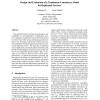Free Online Productivity Tools
i2Speak
i2Symbol
i2OCR
iTex2Img
iWeb2Print
iWeb2Shot
i2Type
iPdf2Split
iPdf2Merge
i2Bopomofo
i2Arabic
i2Style
i2Image
i2PDF
iLatex2Rtf
Sci2ools
OSDI
2000
ACM
2000
ACM
Design and Evaluation of a Continuous Consistency Model for Replicated Services
The tradeoffs between consistency, performance, and availability are well understood. Traditionally, however, designers of replicated systems have been forced to choose from either strong consistency guarantees or none at all. This paper explores the semantic space between traditional strong and optimistic consistency models for replicated services. We argue that an important class of applications can tolerate relaxed consistency, but benefit from bounding the maximum rate of inconsistent access in an application-specific manner. Thus, we develop a set of metrics, Numerical Error, Order Error, and Staleness, to capture the consistency spectrum. We then present the design and implementation of TACT, a middleware layer that enforces arbitrary consistency bounds among replicas using these metrics. Finally, we show that three replicated applications demonstrate significant semantic and performance benefits from using our framework.
Consistency | Operating System | Optimistic Consistency Models | OSDI 2000 | Strong Consistency Guarantees |
| Added | 01 Nov 2010 |
| Updated | 01 Nov 2010 |
| Type | Conference |
| Year | 2000 |
| Where | OSDI |
| Authors | Haifeng Yu, Amin Vahdat |
Comments (0)

